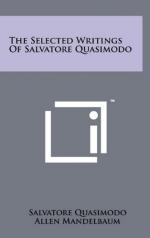|
This section contains 21,069 words (approx. 71 pages at 300 words per page) |

|
SOURCE: Jones, Frederic J. “Salvatore Quasimodo and the Collapse of Hermeticism.” In Modern Italian Lyric, pp. 512-61. Cardiff, Wales: University of Wales Press, 1986.
In the following essay, Jones traces the development of Quasimodo as first a hermetic and later a more socially engaged poet. Examining Quasimodo's oeuvre from Acque et terre (1930) through Dare e avare, the author finds that Quasimodo's lyrical aesthetic style and overarching humanism contribute to his importance in twentieth century poetry, and that Quasimodo's work is at his most powerful when his imagery is least idiosyncratic.
Quasimodo's position in the hermetic movement is rather more complicated to assess than that of the poets considered hitherto, for just as Ungaretti first initiated and then lived the hermetic revolution of the twenties and thirties, so he first stimulated and then largely lived the humanist revolution of the forties and fifties. Moreover, this second revolution, far from being...
|
This section contains 21,069 words (approx. 71 pages at 300 words per page) |

|


